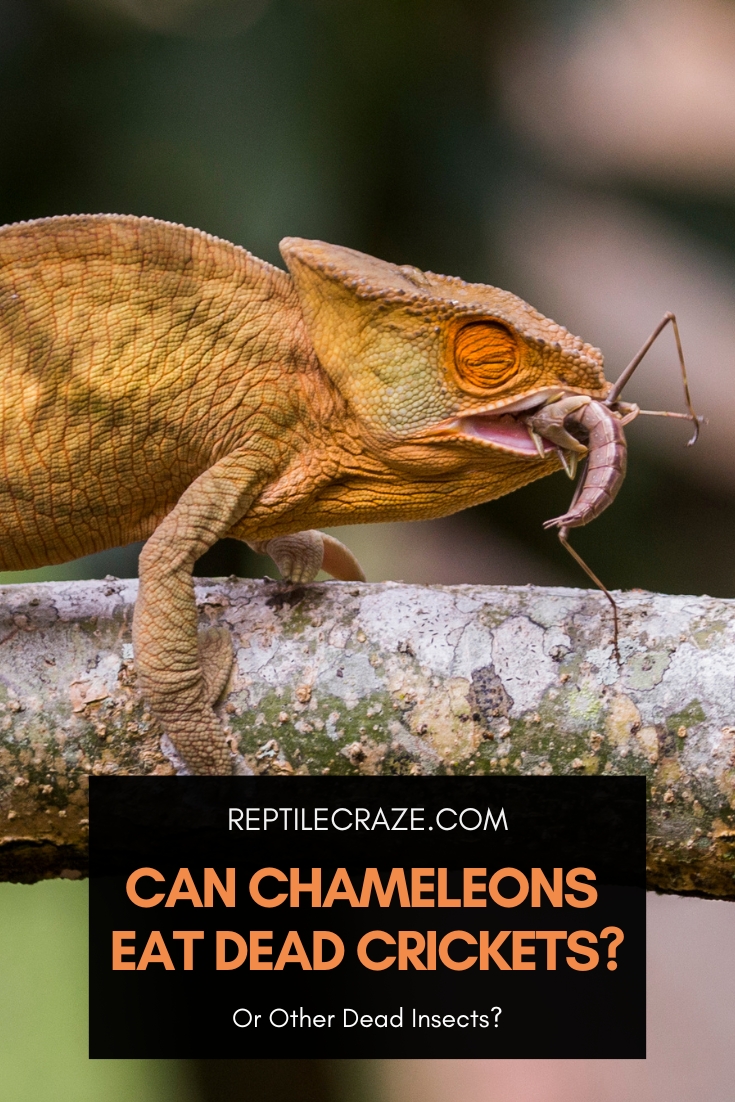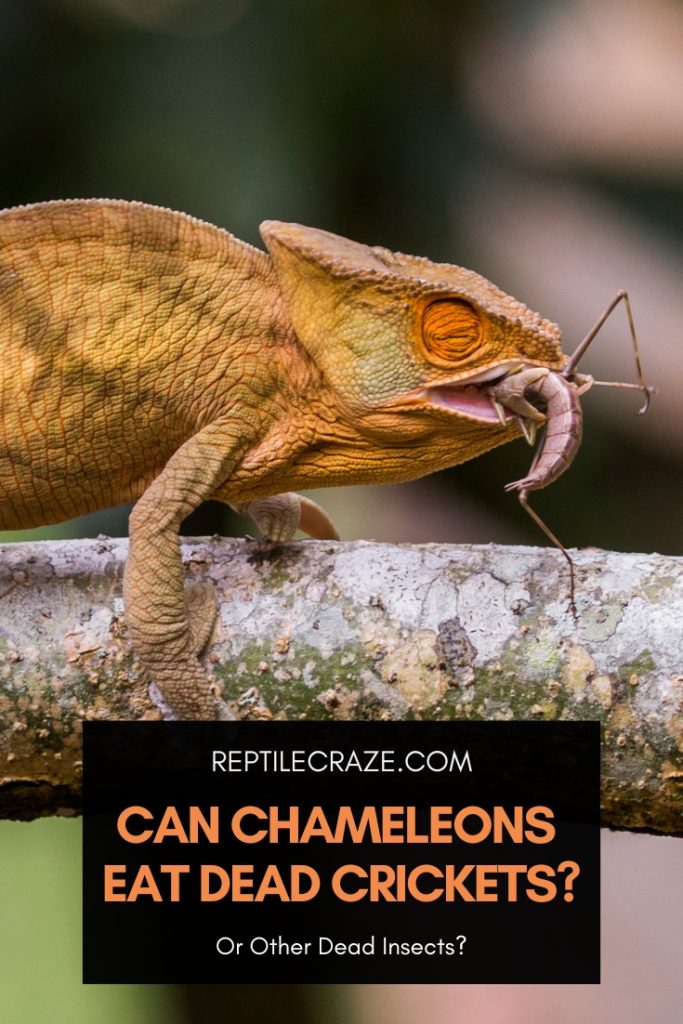Chameleons are fascinating creatures that have unique abilities to change their colors and blend into their surroundings. As a pet owner, you might be wondering if feeding them dead crickets is a safe and healthy option. After all, it’s not uncommon to find leftover crickets in their enclosure that have passed away.
Many chameleon owners have asked the same question, and the answer is not so straightforward. In this article, we will explore whether chameleons can eat dead crickets, the potential risks, and some alternative feeding options to keep your pet healthy and happy.

Can Chameleons Eat Dead Crickets?
If you’re a chameleon owner, you know how important it is to provide your pet with a healthy and well-balanced diet. While live crickets are a common staple in a chameleon’s diet, you may wonder if it’s safe to offer them dead crickets as well. In this article, we’ll explore whether or not chameleons can eat dead crickets and what you need to know about feeding your chameleon a healthy diet.
1. Can Chameleons Eat Dead Crickets?
Chameleons are known for their unique feeding habits and require live prey to stimulate their natural hunting instincts. However, chameleons can eat dead crickets if they are still fresh and haven’t started to decompose. Dead crickets that have been left in the enclosure for too long can start to harbor bacteria and fungi that can be harmful to your chameleon’s health.
While dead crickets may not offer the same level of stimulation and exercise as live crickets, they can still provide your chameleon with essential nutrients and protein. However, it’s important to note that chameleons should not rely solely on a diet of dead crickets and should be offered a variety of live prey as well.
2. Benefits of Feeding Your Chameleon Dead Crickets
Feeding your chameleon a diet that includes dead crickets can offer several benefits. For one, dead crickets are easier to store and transport than live crickets, making them a convenient option for chameleon owners. Additionally, dead crickets are less likely to escape from the enclosure and create a mess.
Dead crickets can also be a good option for chameleons that are ill or injured and may not have the energy to hunt live prey. Offering your chameleon dead crickets can ensure that they are still getting the nutrients they need without the added stress of hunting.
3. Risks of Feeding Your Chameleon Dead Crickets
While offering your chameleon dead crickets can offer benefits, there are also some risks to consider. Dead crickets that have been left in the enclosure for too long can start to decompose and harbor bacteria and fungi that can be harmful to your chameleon’s health.
Additionally, chameleons that are used to hunting live prey may not be as interested in dead crickets, which can lead to a lack of appetite and potential malnourishment. If you do choose to offer your chameleon dead crickets, it’s important to monitor their behavior and ensure that they are still eating enough to maintain a healthy diet.
4. Live Crickets Vs. Dead Crickets
While chameleons can eat both live and dead crickets, live crickets offer several benefits that dead crickets cannot. For one, live crickets provide more stimulation and exercise for your chameleon, which can help keep them active and healthy.
Live crickets also offer the opportunity for your chameleon to hunt and stimulate their natural instincts. Additionally, live crickets are less likely to harbor harmful bacteria and fungi than dead crickets that have been left in the enclosure for too long.
5. How to Offer Your Chameleon Dead Crickets
If you do choose to offer your chameleon dead crickets, it’s important to do so in a safe and hygienic manner. First, make sure that the dead crickets are fresh and haven’t started to decompose.
You can either purchase dead crickets from a pet store or online retailer, or you can purchase live crickets and freeze them to use as needed. Once you have the dead crickets, offer them to your chameleon in a separate dish or on a feeding tong to prevent them from being mixed in with live crickets and causing confusion.
6. How Often Should You Offer Dead Crickets?
While chameleons can eat dead crickets, they should not rely solely on a diet of dead prey. It’s important to offer your chameleon a variety of live prey as well to ensure that they are getting all the nutrients they need.
If you do choose to offer dead crickets, you can do so once or twice a week as a supplement to their regular diet. However, it’s important to monitor your chameleon’s behavior and ensure that they are still eating enough live prey to maintain a healthy diet.
7. Other Prey Options for Chameleons
In addition to crickets, chameleons can also eat a variety of other prey items, including mealworms, waxworms, and silkworms. Offering your chameleon a variety of prey can help ensure that they are getting a well-balanced diet and all the nutrients they need.
It’s important to note that not all prey items are created equal, and some may be more nutritious and easier to digest than others. Do your research and consult with a veterinarian or experienced chameleon owner to determine which prey items are best for your chameleon.
8. Signs of a Healthy Diet
Feeding your chameleon a healthy and well-balanced diet is essential for their overall health and wellbeing. Signs that your chameleon is getting a healthy diet include a healthy weight, vibrant coloration, and regular bowel movements.
If you notice any changes in your chameleon’s behavior or appearance, it’s important to consult with a veterinarian to determine if there are any underlying health issues that need to be addressed.
9. Conclusion
In conclusion, chameleons can eat dead crickets if they are still fresh and haven’t started to decompose. While dead crickets can offer several benefits, they should not replace a diet of live prey and should be offered as a supplement to ensure a well-balanced diet.
It’s important to monitor your chameleon’s behavior and ensure that they are still eating enough live prey to maintain a healthy diet. Additionally, it’s important to offer dead crickets in a safe and hygienic manner to prevent the spread of harmful bacteria and fungi.
10. Additional Resources
– “Feeding Your Chameleon” by ReptiFiles
– “Chameleon Nutrition” by Chameleons Online
– “Chameleon Care Guide” by MadagascarChameleonCare.com
Frequently Asked Questions
Can chameleons eat dead crickets?
Chameleons are known to be insectivores, and crickets are one of their favorite foods. However, it is recommended that you feed your chameleon live crickets, rather than dead ones. This is because chameleons are more likely to recognize and hunt live prey, which helps to stimulate their natural hunting instincts.
Additionally, dead crickets can quickly begin to decompose and develop harmful bacteria, which can be dangerous for your chameleon to consume. Therefore, it is best to avoid feeding your chameleon dead crickets, and opt for live ones instead.
What other insects can I feed my chameleon besides crickets?
There are a variety of insects that you can feed your chameleon besides crickets. Some popular options include mealworms, superworms, waxworms, and hornworms. It is important to remember to vary your chameleon’s diet and not rely solely on one type of insect.
You can also consider feeding your chameleon other insects, such as roaches or grasshoppers. However, make sure to research the specific type of insect beforehand, as some may not be suitable for your chameleon’s diet or may carry harmful parasites.
How often should I feed my chameleon?
The frequency at which you should feed your chameleon depends on its age and size. Generally, adult chameleons should be fed every other day, while juvenile chameleons should be fed daily. It is important to monitor your chameleon’s weight and adjust their feeding schedule accordingly.
Additionally, make sure to provide your chameleon with a variety of insects and supplement their diet with calcium and vitamin D3 to ensure they receive all necessary nutrients.
Can chameleons eat fruits and vegetables?
While chameleons are primarily insectivores, some species may also eat fruits and vegetables in the wild. However, it is important to note that not all fruits and vegetables are safe for chameleons to consume.
Some safe options include leafy greens such as kale or collard greens, as well as fruits such as apples or blueberries. However, make sure to research and avoid feeding your chameleon any fruits or vegetables that may be toxic to them, such as avocado or rhubarb.
What should I do if my chameleon is not eating?
If your chameleon is not eating, it may be a sign of illness or stress. Make sure that your chameleon’s enclosure is properly set up with adequate temperature, humidity, and lighting. Additionally, make sure that your chameleon is not experiencing any other health issues, such as parasites or respiratory infections.
If your chameleon continues to refuse food, it may be best to consult with a veterinarian who specializes in reptiles to determine the underlying issue and develop a treatment plan.
Why is My Chameleon Not Eating Crickets?
In conclusion, chameleons are known to be picky eaters and their diet is mostly composed of live insects. While they may occasionally eat dead crickets, it is not recommended as it may pose health risks to your pet. Dead crickets can harbor harmful bacteria and parasites that can cause digestive problems and even death in chameleons.
As a responsible pet owner, it is crucial to ensure that your chameleon is getting the proper nutrition it needs to thrive. Providing a varied diet of live insects, such as crickets, mealworms, and waxworms, along with fresh fruits and vegetables, can help keep your chameleon healthy and happy.
If you are unsure about what to feed your chameleon or have any concerns about their diet, it is best to consult with a veterinarian or a reptile specialist. They can provide you with the necessary information and guidance to ensure that your chameleon is receiving the best care possible.


